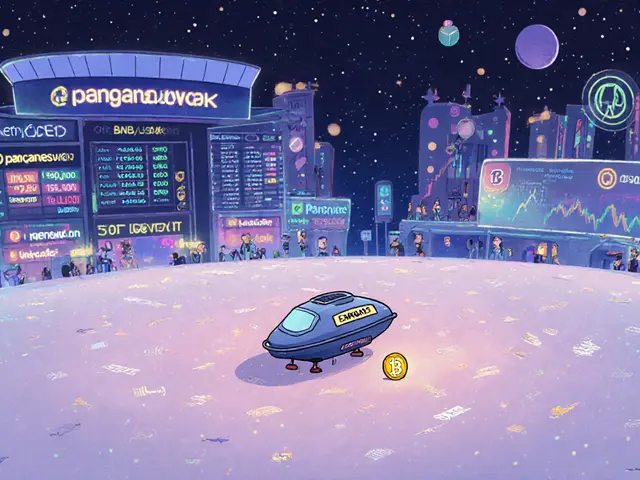SynFutures v2 Platform Overview
Base Layer 2 Technology
Leverages Optimistic rollups for low fees and fast transactions. Gas costs are typically under $0.01 per transaction.
AI-Driven Market Making
Machine learning models optimize AMM pricing, reduce slippage, and improve capital efficiency.
Product Suite
Perpetual futures, synthetic assets, NFT derivatives, and Bitcoin hash-rate contracts.
F Token Economy
Governance and incentive token with current circulating supply of 1.2 billion.
F Token Price Forecast Calculator
Projected F Token Price (2025)
Platform Comparison
SynFutures offers broader product coverage than competitors like dYdX but still faces liquidity and smart-contract risks common to DeFi platforms.
If you’re hunting for the next‑gen place to trade perpetual futures, synthetic tokens, or even NFT‑linked contracts, you’ve probably heard the name SynFutures review pop up on forums and Twitter. The buzz centers on a decentralized exchange that claims to merge AI‑powered market making with the cheap, fast rollup tech of Base Layer2. This article breaks down what the platform actually offers, how it works under the hood, and whether the hype translates into a solid trading experience.
Key Takeaways
- SynFutures v2 runs on Base Layer2 (Optimistic rollups), delivering gas fees that are a fraction of Ethereum mainnet.
- AI‑driven optimization refines AMM pricing, cuts slippage, and improves capital efficiency.
- Traders can access perpetual futures, synthetic assets, NFT derivatives, and Bitcoin hash‑rate contracts-all permissionless.
- The native F token (F) serves governance and incentive roles, but price forecasts remain volatile.
- Compared with rivals like dYdX, SynFutures offers broader product coverage but still faces liquidity and smart‑contract risk challenges.
What Is SynFutures v2?
SynFutures is a decentralized derivatives exchange built on the Base Layer2 ecosystem, leveraging AI‑enhanced automated market makers to enable perpetual futures, synthetic assets, and more. Launched as the first DEX on Base, the platform markets itself as “the most expansive decentralized derivatives marketplace” covering everything from blue‑chip crypto to NFT‑linked contracts. The ‘v2’ upgrade introduced AI‑based liquidity optimization and a revamped UI that targets both seasoned traders and newcomers.
Technical Backbone - Base Layer2 and Optimistic Rollups
SynFutures’ performance hinges on Base Layer2 (an Optimistic rollup built on Ethereum that aggregates transactions off‑chain and posts succinct proofs on‑chain. By batching trades, the rollup slashes gas costs to under $0.01 per transaction and accelerates settlement to sub‑second finality. This contrasts sharply with Ethereum mainnet, where fees can surge above $10 during peak demand.
Behind the scenes, the platform runs on Optimistic rollups (a scaling solution that assumes transactions are valid unless proven otherwise, allowing for fast block times and low fees. The rollup’s fraud‑proof window adds a security layer by giving validators the chance to challenge incorrect state updates.

AI‑Driven Market Making
One of SynFutures’ unique selling points is its AI‑driven optimization (machine‑learning models that continuously calibrate AMM curves, predict volatility, and adjust collateral requirements in real time. The AI layer monitors order flow, on‑chain price feeds, and historical volatility to minimize slippage and protect against price manipulation. For liquidity providers, this means higher capital efficiency-your deposited assets are more likely to be utilized effectively without exposing you to outsized risk.
Product Suite
The exchange supports several derivative categories:
- Perpetual futures (derivative contracts with no expiry that settle continuously via funding rates, available for major cryptos, altcoins, and even Bitcoin hash‑rate tokens.
- Synthetic assets (tokenized representations of underlying assets that track price movements without holding the asset itself, ranging from BTC and ETH to NFT index tokens.
- NFT‑linked derivatives that let you speculate on floor‑price movements of popular collections.
- Bitcoin hash‑rate contracts, allowing exposure to mining power without owning mining equipment.
All products are fully collateralized: you must lock crypto (usually USDC, ETH, or the underlying token) as margin before opening a position. Collateral ratios adjust dynamically based on the AI risk model and the volatility of the underlying asset.
Token Economics - The F Token
The native governance token, F token (the utility and governance token for SynFutures, used to vote on protocol upgrades and earn fee rebates, was minted in a 2023 token sale. Current circulating supply sits around 1.2billion, with a max cap of 2billion. Token holders can stake F to receive a portion of the platform’s trading fees, and staking also boosts their voting power on proposals such as new product launches or fee structure changes.
Price forecasts remain divided. Some analytics platforms project a 2025 price near $0.0862 (a ~492% upside), while others see a range of $0.017-$0.032. Volatility is high-September 2025 saw a 95% jump, but other months recorded losses exceeding 40%.
Trading Experience - UI, Fees, and Liquidity
The web UI is clean, with separate tabs for Perpetuals, Synths, and NFT derivatives. Wallet integration works with MetaMask, Coinbase Wallet, and the native Base wallet. Because the exchange runs on Base, transaction fees for swaps and position adjustments are typically under $0.01, which is a stark improvement over Ethereum’s $5‑$10 range.
Liquidity depth varies by market. Top‑tier assets like ETH‑USDC perpetuals have tight spreads (often <0.05% thanks to AI‑tuned AMM curves), while niche NFT synths can exhibit spreads of 0.5% or more. Liquidity providers earn a base fee of 0.10% per trade, plus a performance bonus when AI predicts low‑risk periods.

Competitive Landscape - SynFutures vs. dYdX
| Feature | SynFutures v2 | dYdX |
|---|---|---|
| Scaling layer | Base Layer2 (Optimistic rollups) | StarkWare (ZK‑rollups) |
| Typical gas cost per trade | ≈ $0.01 | ≈ $0.005 (with upcoming fee‑free model) |
| AI‑driven AMM | Yes - dynamic pricing & collateral | No - traditional AMM |
| Product breadth | Perpetuals, synthetic assets, NFT derivatives, hash‑rate contracts | Perpetuals, options, spot trading |
| Governance token | F token (staking rewards) | DYDX token (staking for liquidity mining) |
| Liquidity incentives | AI‑adjusted performance bonuses | Fixed APR pools |
In short, SynFutures shines in product variety and AI‑enhanced pricing, while dYdX leads on ultra‑low fees and a more mature user base. Your choice depends on whether you value cutting‑edge synthetic exposure or raw cost efficiency.
Risks and Considerations
- Smart‑contract risk: As a fully on‑chain platform, any bug could expose funds. The code is audited, but audits are not a guarantee.
- Liquidity variance: Niche markets can suffer from thin order books, leading to higher slippage.
- Regulatory uncertainty: Derivative products face tighter scrutiny in several jurisdictions; users should verify local compliance.
- Token volatility: The F token’s price swings can affect staking rewards and governance voting power.
Final Verdict
SynFutures v2 positions itself as a bold experiment at the crossroads of AI, DeFi, and rollup scaling. For traders who want a one‑stop shop for perpetuals, synthetic assets, and even NFT‑linked contracts, the platform offers impressive fee savings and innovative pricing tools. However, the novelty comes with liquidity gaps in niche markets and the usual smart‑contract exposure that every DeFi user must accept. If you’re comfortable navigating those risks and value AI‑optimized execution, SynFutures is worth a test run. Otherwise, more established DEXes like dYdX may provide a smoother, lower‑risk experience.
Frequently Asked Questions
What blockchain does SynFutures run on?
SynFutures is built on Base Layer2, an Optimistic rollup that inherits security from Ethereum while offering cheap, fast transactions.
How does the AI optimization work?
The platform feeds real‑time market data into machine‑learning models that adjust AMM curves, collateral ratios, and fee rebates. The goal is to lower slippage and improve capital efficiency for both traders and liquidity providers.
Can I trade Bitcoin hash‑rate contracts on SynFutures?
Yes. The platform offers synthetic contracts that track the performance of Bitcoin mining hash‑rate, letting you speculate without owning mining hardware.
Is the F token required to trade?
No. You can open and close positions using standard ERC‑20 assets for collateral. The F token is optional but provides fee rebates and governance voting power when staked.
How do fees on SynFutures compare to Ethereum mainnet?
Because trades settle on Base, typical gas fees are under $0.01 per transaction, compared with $5‑$10 on Ethereum during busy periods.






EDWARD SAKTI PUTRA
The gas fees on Base really make a difference.
Ritu Srivastava
It's reprehensible how platforms tout AI-driven market making as a miracle while ignoring the ethical implications of ceding price discovery to opaque algorithms; traders are being lured into a system that prioritizes profit over fairness, and that's simply unacceptable.
Liam Wells
Whilst the documentation purports to elucidate the underlying mechanisms of the Optimistic rollup, one must observe, with due scrutiny, that the exposition suffers from a paucity of empirical validation; consequently, the purported reduction in slippage remains, at best, speculative, and at worst, a veneer for unmitigated risk.
Marcus Henderson
In contemplating the trajectory of decentralized finance, one discerns that innovations such as SynFutures v2 embody the quintessential spirit of collective advancement; when participants align around shared utility, the ecosystem matures beyond mere speculative fervor.
Andrew Lin
U.S. traders need to stop chasing every new fadt and realize that these foreign platforms are just a way for outsiders to steal our market share.
Matthew Laird
While concerns about ethical AI are not unfounded, the data-driven liquidity enhancements demonstrably tighten spreads, which benefits the average retail participant far more than any abstract notion of algorithmic purity.
Ken Pritchard
It's understandable to feel uneasy about AI, but many users have reported smoother execution and lower fees since the upgrade; perhaps a balanced view would acknowledge both the risks and the tangible improvements.
Brian Lisk
Indeed, the integration of machine‑learning models into the AMM architecture represents a paradigm shift that warrants thorough examination. First, the adaptive pricing algorithms continuously ingest order‑book data, adjusting liquidity curves in near‑real time, thereby reducing the typical slippage encountered on static pools. Second, this dynamism translates into more efficient capital utilization, as providers witness higher turnover rates on their deposited assets. Third, the reduction in execution latency-owing to Base's sub‑second finality-further compounds the user experience, making rapid arbitrage less prevalent. Fourth, empirical observations from on‑chain metrics indicate a marked decline in variance of funding rates across perpetual contracts. Fifth, the governance token incentives are calibrated to reward those who contribute to depth, aligning economic interests with network health. Sixth, the risk management layer leverages volatility forecasts to adjust collateral ratios, shielding participants from abrupt market swings. Seventh, community feedback loops have been instituted, allowing stakers to propose refinements to the AI parameters, fostering a participatory model. Eighth, the transparent audit trails ensure that any anomalous behavior can be traced back to its source, bolstering trust. Ninth, the layered security audits performed by third‑party firms provide an additional safeguard against smart‑contract exploits. Tenth, the platform's open‑source ethos permits independent researchers to validate the underlying models, enhancing credibility. Eleventh, the modular architecture facilitates future upgrades without necessitating full migrations, preserving user continuity. Twelfth, the incorporation of synthetic assets broaden exposure options, attracting a diversified user base. Thirteenth, NFT‑linked derivatives introduce novel use‑cases that blend DeFi with the burgeoning digital art market. Fourteenth, the overall reduction in gas costs democratizes access, allowing smaller traders to participate without prohibitive fees. Fifteenth, the cumulative effect of these enhancements positions SynFutures as a noteworthy contender in the evolving DeFi derivatives landscape. Sixteenth, nonetheless, vigilance remains essential, as the interplay of AI and finance introduces complexities that demand ongoing community oversight.
Richard Bocchinfuso
i think the f token price could blow up if they keep the fees low.
Dawn van der Helm
Love the low fees and the fresh UI! 🚀💡
Michael Phillips
Appreciate the enthusiasm; the interface does indeed streamline position management for newcomers.
Franceska Willis
Honestly, I once tried to predict the hash‑rate contracts and ended up staying up all night; the thrill was real, but I wish there were more community tutorials to guide newbies through the nuances.
Jack Stiles
The gas cost is cheap, which is nice.
Darren Belisle
Indeed; the sub‑dollar transaction fees, combined with rapid finality, render the platform remarkably accessible-even for casual participants!;
Heather Zappella
From a tokenomics perspective, the F token's supply cap of two billion, coupled with a staking‑based fee rebate mechanism, creates a clear incentive structure for long‑term holders while simultaneously funding protocol development.
Jason Wuchenich
That explanation helps a lot; understanding the rebate schedule makes it easier to decide how much to stake.
Caitlin Eliason
Speculating on synthetic assets is nothing short of financial heresy; we must resist the lure of fleeting profits and champion responsible, value‑based investing! 😤
Bryan Alexander
Even if the market swings, the innovative AI layers give us a fighting chance to navigate volatility with confidence.
Patrick Gullion
True, but remember that over‑reliance on AI can blind traders to fundamentals; a balanced approach wins the day.